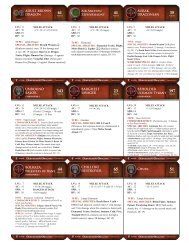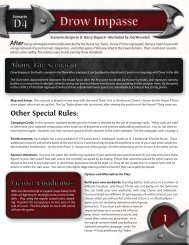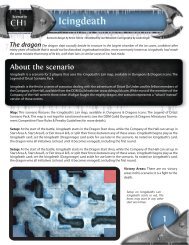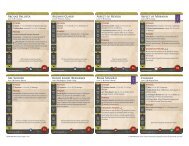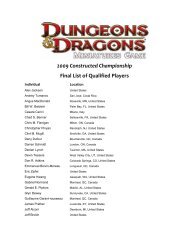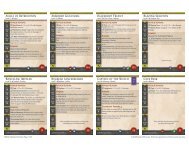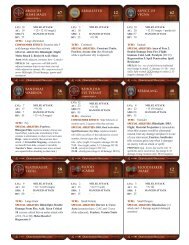Create successful ePaper yourself
Turn your PDF publications into a flip-book with our unique Google optimized e-Paper software.
Attack Rolls<br />
When a creature attacks, you make an attack roll.<br />
Attacking<br />
Roll the d20, add the creature’s Melee Attack number, and add any modifiers that<br />
apply (see page 17 for the list of attack modifiers). If the result of an attack roll<br />
equals or exceeds the enemy’s AC (Armor Class), the attack hits. The attacking<br />
creature deals its melee damage, reducing the enemy’s HP (hit points). Track<br />
damage with the provided counters.<br />
Natural 20 is a Critical Hit: If you roll a natural 20 when making an attack roll (a roll of<br />
20 on the die, regardless of modifiers), the attack automatically hits, no matter how high the<br />
defender’s AC. In addition, it is a critical hit and deals double damage. Some creatures are<br />
immune to critical hits and do not take double damage, but a natural 20 still hits automatically.<br />
If a creature somehow can score a critical hit on a roll of less than 20, that still counts as an<br />
automatic hit.<br />
Bonus Damage: Some attacks list bonus damage, shown by a “+” sign. For example, the Brass<br />
Samurai’s melee attack deals “10 magic + 5 fire.” Bonus damage is not doubled on a critical<br />
hit or an attack against a helpless creature.<br />
Natural 1 is an Automatic Miss: If you roll a natural 1 when making an attack roll (a roll of<br />
1 on the die, regardless of modifiers), the attack automatically misses, no matter how low the<br />
defender’s AC.<br />
Attacking Allied Creatures: A creature cannot make a melee or ranged attack against an<br />
allied creature. This restriction doesn’t prevent you from targeting or affecting allied creatures<br />
with spells and special abilities—just attacks.<br />
Damage Effects<br />
Reduced to Half Hit Points: When a creature’s hit points first drop to half its starting total or<br />
lower, it must make a morale save to avoid running away. See Morale on page 21 for more<br />
information.<br />
Reduced to 0 Hit Points: When a creature’s hit points drop to 0 or below, it’s<br />
destroyed and removed from the battle map.<br />
Threatening<br />
Even when a creature isn’t actually attacking an enemy, it can limit the actions of adjacent<br />
enemies. An active creature threatens all squares adjacent to it.<br />
Effects of Threatening: A creature can make an attack of opportunity (see page 13) against<br />
an enemy creature that moves out of a square it threatens. An enemy cannot cast spells (other<br />
than those with a range of touch) or make ranged attacks while it is in a square threatened by<br />
your creature. However, that enemy can use special abilities.<br />
Cover: If the threatening creature can’t see the acting creature or if the acting creature<br />
has cover against the threatening creature, these restrictions don’t apply: The creature in the<br />
threatened square can move without provoking an attack of opportunity, as well as cast spells<br />
or make ranged attacks.<br />
11



